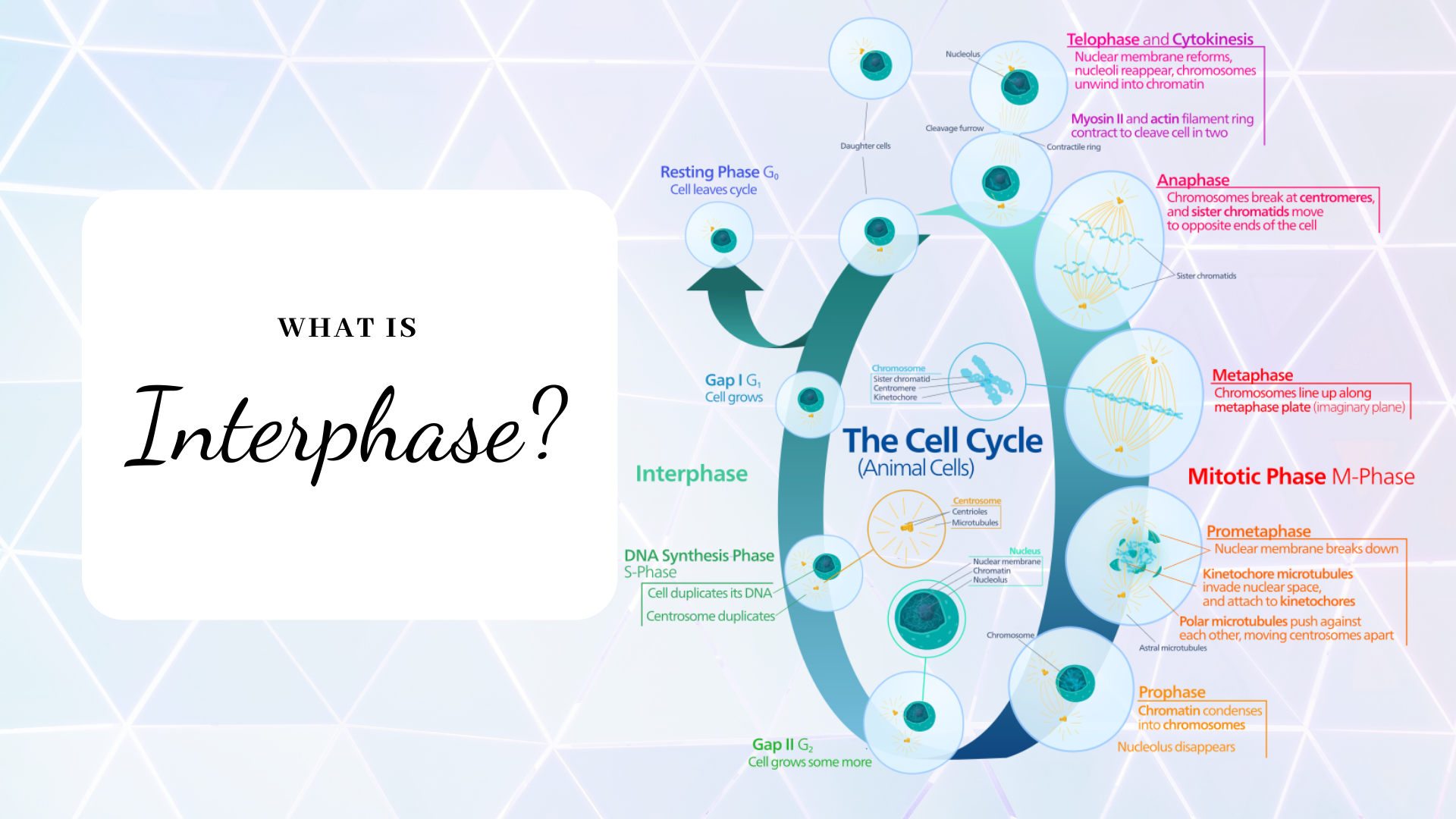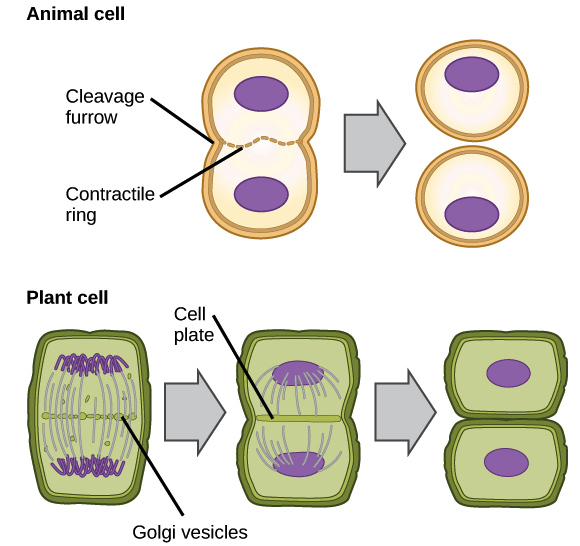
During interphase of a cell cycle, the cell copies DNA, grows, and carries out its normal functions. The cell cycle refers to the cycle that has cells reproduce and divide. The cell cycle is divided into two or three main phases: interphase, mitosis, and cytokinesis. What exactly happens in the interphase of a cell cycle?
In order to properly describe what happens in interphase of the cell cycle, it would be helpful to place it in context and look at the cell cycle as a whole.
Why Is The Cell Cycle Necessary?
The cells of an animal must undergo the cell cycle for various reasons. The cell cycle helps cellular systems grow and produce more cells, capable of creating larger, more complex structures. The cell cycle is also responsible for the replacement of cells. When a cell is damaged or wears out from use, it must be replaced by another cell that can carry out the same function.
The Cell Cycle
The cell cycle is what creates new cells. The actual replication and division of a single cell into two different cells happens during mitosis and cytokinesis. The rest of the cell phase consists of interphase, and the cell grows and replicates DNA during this time.
- Interphase: Makes up the time between one mitotic phase and the next. The cell grows and copies DNA.
- Mitotic phase: Sees the division of one cell into two different cells. The process of mitosis creates doubles of necessary organelles, while the process of cytokinesis divides the cell into two cells.
The cells of humans usually take about 24 hours to completely divide and create two cells, though some cells in the human body (like those in the intestines) can complete this cycle in only about 9-10 hours under the right circumstances. Note that sex cells have another phase called meiosis, which is where they divide to form four daughter cells that each have half of the number of chromosomes that the parent cell does.
Interphase Of The Cell Cycle8*
The interphase of a cell can itself be subdivided into three separate chunks:
- Gap 1
- Synthesis
- Gap 2

The cell cycle with G0 shown on the right side. Cytokinesis happens rapidly in the cell cycle and isn’t represented. Photo: By Cell_Cycle_2.png: The original uploader was Zephyris at English Wikipediaderivative work: Beao – Cell_Cycle_2.png, CC BY-SA 3.0, https://commons.wikimedia.org/w/index.php?curid=9550386
G1
Gap 1, or G1, begins immediately after one cell has divided into two. The parent cell has already finished dividing chromosomes and the process of cytokinesis has created two new cells. G1 represents a return to normal function, the cell begins carrying out its regular tasks, growing in size while it does so and replicating any organelles it needs. It also begins to synthesize the molecular compounds it needs for later steps in the cell cycle.
If a cell needs to perform specialized functions, it must differentiate. The cell must leave the G1 phase to go into a resting state where it can differentiate, a phase known as G0. Some cells won’t re-enter G1 and begin dividing again, while others will.
Though cells typically grow before division, not all will. Certain cells may purposefully divide again and again without growing, splitting themselves into many small cells pieces over multiple rounds of division. This rarely happens, but some animals, like certain frogs, use this method to create embryos.
“A cell has a history; its structure is inherited, it grows, divides, and, as in the embryo of higher animals, the products of division differentiate on complex lines. Living cells, moreover, transmit all that is involved in their complex heredity.” — Frederick Gowland Hopkins
S-Phase
In synthesis, or S-Phase, the cell ceases performing its normal functions. All of the cell’s resources and energy will be utilized to replicate DNA. The two interwoven strings of DNA need to be unzipped to be read and the genetic information within accessed. The unzipping process is done by a number of different proteins. During synthesis, the cell will also begin creating identical copies of each chromosome, and the copies of the individual DNA strands are bound together in a structure called a sister chromatid.
What happens with these sister chromatids depends upon the type of cell. Most cells are somatic cells, and during mitosis, the sister chromatids will be separated, ensuring that there are two copies of the DNA in each cell. Meanwhile, gametes (sex cells) will enter the meiosis phase instead of mitosis after interphase completes. During meiosis, two rounds of division occur instead of only one. The homologous chromosomes are separated in the first round of division, then the sister chromatids separate in the next. This is what leads to four haploid cells, which only have half of the entire genome.
After the end of synthesis, the cell starts to prepare for cell division once more.
G2
Gap2, or G2, happens after the DNA has been replicated. During this phase, the cells begin to increase in size by creating more cytoplasm. Many important organelles like the mitochondria, which provide the cell with energy, are replicated in this stage. Plants cells will create both chloroplasts and mitochondria, while animal cells will only create mitochondria. The G2 phase continues until the cell enters mitosis or meiosis. After cell division is complete, the cell cycle will start again at G1.
What Happens In Mitosis?
Mitosis is itself divided into phases:
- prophase
- prometaphase
- metaphase
- anaphase
- telophase
During prophase the chromosomes condense around each other, while the nuclear envelope surrounding the nucleolus disappears, letting the contents of the nucleolus out into the cytoplasm.
Prometaphase sees the chromosomes keep condensing while a structure called the mitotic spindle forms, which is necessary to separate the chromosomes.
Metaphase has the chromosomes line up at the center of the cell, in between the two halves of the mitotic spindle. The sister chromatids are now attached to structures called centrosomes via another structure called a microtubule.
Anaphase has the chromatids pulled apart, and the freed chromosomes are pulled towards opposite poles of the cell, where they will stay as the cell divides. The cell elongates as the fibers of the mitotic spindle lengthen.
During telophase, the chromosomes arrive at opposite sides of the cell where they begin to unravel and decondense. Nuclear envelopes begin to rebuild themselves around each set of chromosomes. Finally, the mitotic spindle is broken down as the cell prepares to head back into interphase.

Photo: “The cell cycle: Figure 1” by OpenStax College, Biology (CC BY 3.0).
Cytokinesis separates the cells, creating two cells. This is done with cleavage in animal cells, as the cell is “pinched” in the middle until it divides in two. Plant cells simply create a new cell wall down the center of the cell.
“All of today’s DNA, strung through all the cells of the earth, is simply an extension and elaboration of [the] first molecule.” — Lewis Thomas
Interphase is an important and necessary part of the cell cycle. It enables the cell to reset itself after division and carry out its normal functions.









